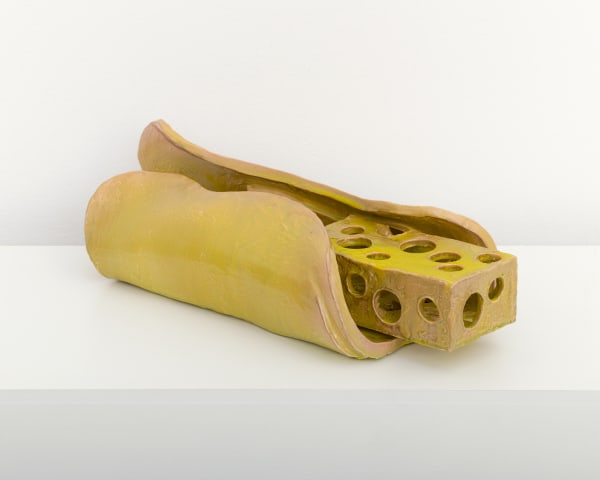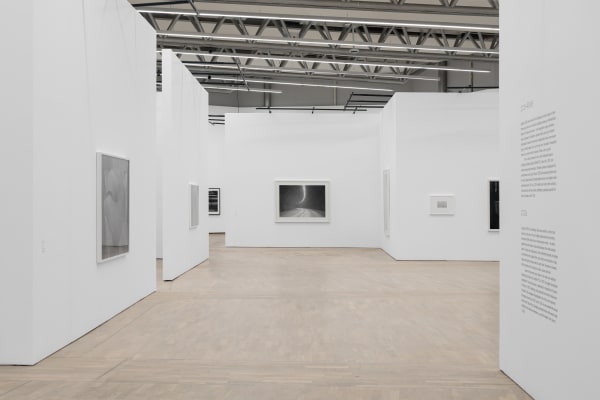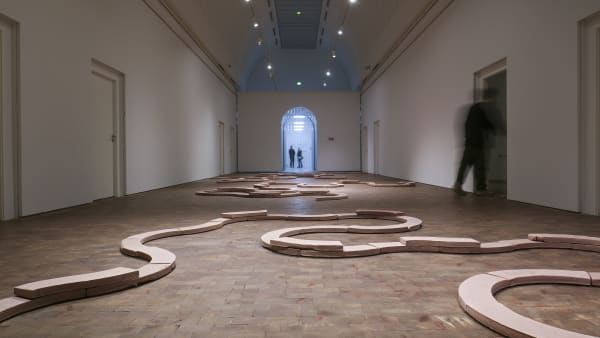-

Tove Storch · Gredstedbro Church
Public Installation January 17, 2026 Saturday, January 17, 2026, marks the official inauguration of Gredstedbro Church following its renovation, and the unveiling of a new... Read more -

Tom Sandberg · The Guardian · 'Was it a woman who bit off his ear?': the wild life and serene photography of Tom Sandberg
Press December 2, 2025 The Guardian: ' ‘Was it a woman who bit off his ear?’: the wild life and serene photography of Tom... Read more -

Charlotte Brüel · Arthur Köpcke’s Memorial Fund
Grant November 26, 2025 The gallery is proud to announce that Charlotte Brüel has been awarded an honorary grant from Arthur Köpcke’s Memorial Fund.... Read more
-

Nils Erik Gjerdevik · Spaces of Possibilities · CLAY Ceramic Museum
Solo Exhibition November 8, 2025 CLAY Ceramic Museum presents its largest exhibition to date featuring the artist Nils Erik Gjerdevik (1962–2016), focusing on his original... Read more -

FOS · PARIS · AARHUS
Public Installation November 1, 2025 Saturday, November 1, 2025, at 10 am marks the official inauguration of PARIS, a new playground by FOS. Placed between... Read more -

Tom Sandberg · Vibrant World · Henie Onstad Kunstsenter
Solo Exhibition October 30, 2025 On 31st October, Henie Onstad Kunstsenter will open the first major retrospective of Tom Sandberg in a Norwegian museum, Tom... Read more
-

Tove Storch · SMK - The National Gallery of Denmark
Acquisition September 10, 2025 We are proud to announce that SMK – The National Gallery of Denmark has recently acquired Untitled (the bows) ,... Read more -

Tove Storch · The Ship · Bavnehøj
Public Installation August 23, 2025 Saturday, August 23, 2025, marks the official inauguration of The Ship , a monumental new public artwork in Copenhagen by... Read more -

Ed Templeton · I’m Obsessed With People · Louisiana Channel
Video August 7, 2025 'Normal athletes are training and drinking water and being safe and these guys are just destroying their bodies inside and... Read more
-

Jone Kvie in Conversation with Charles Teyssou · Artist Talk
Event July 29, 2025 Saturday, August 30, 4 PM NILS STÆRK, Glentevej 49, 2400 Copenhagen On the occasion of Jone Kvie's solo exhibition salthour... Read more -

Torbjørn Rødland · Songs for the Sun · Yuz Museum
Solo Exhibition July 12, 2025 Torbjørn Rødland's exhibition 'Songs for the Sun' at the Yuz Museum in Shanghai opens today, marking Rødland's first solo exhibition... Read more -

SUPERFLEX · One Two Three Swing! · European Parliament
Public Installation July 7, 2025 We’re pleased to share that SUPERFLEX’s One Two Three Swing! is now open in front of the European Parliament in... Read more
-

Olaf Breuning · Sun and Cloud · Heartland Festival
Public Installation June 25, 2025 At this year’s Heartland Festival, Olaf Breuning presented a new site-specific installation titled 'Sun and Cloud'. Standing 10 meters... Read more -

Michael Kvium · Shadow Theatre · Trapholt Museum of Modern Art
Solo Exhibition June 24, 2025 Michael Kvium’s solo exhibition 'Shadow Theatre' opens today at Trapholt Museum of Modern Art and Design in Kolding and runs... Read more -

Darío Escobar · On the Exact Nature of Our Mistakes
Solo Exhibition May 24, 2025 For the first time in 15 years, Darío Escobar shows his work in his home country of Guatamala. View more... Read more
-

Ingvar Cronhammar · Pietas
Public Installation May 20, 2025 Today marks the official inauguration of the Pietas Pavilion at the Regional Hospital in Gødstrup — a space where art,... Read more -

FOS and Lea Porsager · Major Works · Den Frie
Group Exhibition April 26, 2025 FOS & Lea Porsager is both part of the exhibition Major Works at Den Frie, Copenhagen, DK. The exhibition runs... Read more -

Tove Storch · Arte Povera – A New Chapter · EMMA – Espoo Museum of Modern Art
Group exhibition April 9, 2025 Tove Storch is part of the exhibition Arte Povera – A New Chapter at EMMA – Espoo Museum of Modern... Read more
-

FOS and Tove Storch · Denne Nye Verden – Overvejende Tekstil · Lundsgaard Gods
Group Exhibition April 5, 2025 FOS and Tove Storch are a part of the group exhibition, Denne Nye Verden – Overvejende Tekstil , at Lundsgaard... Read more -

Charlotte Brüel · HEART – Herning Museum of Contemporary Art
Acquisition April 3, 2025 The gallery is proud to share the news that HEART - Herning Museum of Contemporary Art has recently acquired a... Read more -

Tove Storch · The Eckersberg Medal
Award March 29, 2025 We are glad share that Tove Storch is awarded the Eckersberg Medal, 2025. The Academy Council of The Royal Academy... Read more
-

SUPERFLEX · The Thorvald Bindesbøll Medal
Award March 29, 2025 We congratulate SUPERFLEX upon their recieval of the Thorvald Bindesbøll Medal, 2025. The The Academy Council of The Royal Academy... Read more -

Runo Lagomarsino · The Process of Materializing Ideas · Louisiana Channel
Video March 12, 2025 “You have to trust what a material can do and not force it.” We met artist Runo Lagomarsino in his... Read more -

Tove Storch · Lasheses · House of Art České Budějovice
Solo Show February 13, 2025 Tove Storch's solo exhibition, Lasheses, opens tomorrow—Thurday, February 13, 2025—at House of Art České Budějovice in the Czech Republic. The... Read more
-

Michael Kvium · Junction · Kunsten Museum of Modern Art
Solo show February 6, 2025 Kunsten Museum of Modern Art Aalborg presents Michael Kvium – Junction. The exhibition opens, February 6, and will be on... Read more -

CARLOS AMORALES · BLACK CLOUD · PHOENIX ART MUSEUM
Solo show January 17, 2025 Carlos Amorlas’ installation Black Cloud is currently on view at Phoenix Art Museum in Greenbaum Lobby and John Morrell Promenade... Read more -

Tove Storch · Glassy Eyes · GLAS – Museum of Glass Art
Solo Show November 23, 2024 Tove Storch's solo exhibition Glassy Eyes opens at GLAS – Museum of Glass Art, in Ebeltoft Denmark November 23, 2024... Read more
-

LEA PORSAGER · AIR DE REPOS (BREATHWORK) · CAPC MUSÉE D´ART CENTEMPARAIN
Group show November 15, 2024 Lea Porsager’s work H.O.L.Y. S.P.I.R.I.T., 2024 is part of the exhibition Air de repos (Breathwork) at the Capc Musée d’art... Read more -

RUNO LAGOMARSINO · SILENCE ANSWERS ALL · MARABOUPARKEN KONSTHALL
Solo Show November 5, 2024 When Picasso painted his monumental work Guernica, a Nazi officer allegedly asked him: “Did you do this?” To which Picasso... Read more -

MICHAEL KVIUM · WETLAND · THE NIVAAGAARD COLLECTION
Solo show October 23, 2024 Kvium’s trademark humour mingles with menacing undertones of danger in his latest renditions of nature, people, faith and gender. Created... Read more
-

FOS · PERMISSION TO FALL · FRIEZE SCULPTURE
Commission September 24, 2024 Permission to fall is a performance that triggers an event evocative of sculpture that occurs through unexpected encounters. For the... Read more -

SUPERFLEX · SUPERCONVERSATION · MUSEUM JORN
Solo show September 11, 2024 SUPERFLEX’ solo exhibition SUPERCONVERSATION will be on view at Museum Jorn from October 11, 2024, to March 2, 2025 .... Read more -

EDUARDO TERRAZAS · WHEN THE WORLD IS WATCHING · SAN FRANCISCO MUSEUM OF MODERN ART
Group Show August 17, 2024 Eduardo Terrazas design for the 1968 Olympics in Mexico, is included in the exhibition When the World Is Watching at... Read more
-

FOS · ABOGADO · MUSEO ANAHUACALLI
Solo Show July 20, 2024 A site-specific intervention by FOS at the Anahuacalli Museum in Mexico City. The project combines sculpture, architecture, design, and music... Read more -

TOVE STORCH · SAMMENBRUD
Group show July 10, 2024 Tove Storch’s work “Untitled” (2024) is part of the exhibition “SAMMENBRUD” at Ved Skoven, on view until September 1, 2024.... Read more -

TOVE STORCH · HEARTLAND FESTIVAL
Solo show July 10, 2024 For Heartland Festival 2024, Tove Storch created a site-specific installation for people to interact with while washing their hands at... Read more
-

LEA PORSAGER · AFTER THE SUN — FORECASTS FROM THE NORTH
Group show July 10, 2024 Lea Porsager’s work “OFFSHORE G.O.D. [Generator. Organizer. Destroyer.], Remains.” (2024) is part of the exhibition ”After the Sun — Forecasts... Read more -

ED TEMPLETON · TURNING THE PAGE
Group show July 10, 2024 Ed Templeton's 'Wires Crossed' is part of the group exhibition ‘Turning the Page’ at Pier 24 Photo Museum, San Francisco,... Read more -

EDUARDO TERRAZAS · MULTIPLE BALANCE: WORKS AND PROJECTS 1968–2023 · THE MUSEUM OF CONTEMPORARY ART OF MONTERREY
Solo show June 25, 2024 The work of Eduardo Terrazas, spanning five decades from 1968 to 2023, is currently featured in a comprehensive exhibition at... Read more
-

LEA PORSAGER & FOS · NABOPLANTER
Group show May 28, 2024 Lea Porsager and FOS are part of the group exhibition 'Naboplanter' at Den Frie Udstillingsbygning. The exhibition is on... Read more -

RUNO LAGOMARSINO · PLATSENS LJUS – SPACES OF LIGHT
Commission May 15, 2024 Runo Lagomarsino's permanent commission 'Platsens ljus – Spaces of Light', 2024, is now completed in the entrance hall of the... Read more -

EDUARDO TERRAZAS · BIENNALE ARTE 2024
Group show April 30, 2024 Eduardo Terrazas' work '1.1.91' (1970/1972) is part of the 60th edition of The International Art Exhibition of La Biennale di... Read more
-

SUPERFLEX · BIENNALE ARTE 2024
Group show April 30, 2024 SUPERFLEX are participating in Biennale Arte 2024 with 'Foreigners, Please Don’t Leave Us Alone With The Danes!' The theme... Read more -

SUPERFLEX · GROUP THERAPY · ARKEN
Group show April 16, 2024 SUPERFLEX' work 'It is Not The End Of The World' is part of the exhibition 'Group Therapy' at Arken Museum... Read more -

GERT & UWE TOBIAS · TO BID THE DOG GOODBYE · Kunstverein Lübeck
Solo Show April 16, 2024 Gert & Uwe Tobias’ solo exhibition “To Bid the Dog Goodbye” at Kunstverein Lübeck, Overbeck-Gesellschaft, is on view through March... Read more
-

ED TEMPLETON · WIRES CROSSED
Solo show April 16, 2024 Do not miss Ed Templeton's solo exhibition 'Wires Crossed: The Culture of Skateboarding, 1995-2012' at Long Beach Museum of Art.... Read more -

SUPERFLEX · BEYOND THE END OF THE WORLD · ICA - INSTITUTE OF CONTEMPORARY ART, SAN DIEGO
Solo show April 12, 2024 SUPERFLEX’ solo exhibition “Beyond The End Of The World,” is on view at ICA - Institute of Contemporary Art, San... Read more -

TOVE STORCH · SLUMPING · GL STRAND
Solo show February 13, 2024 Tove Storch's solo-exhibition Slumping is on view at Gammel Strand until 20.05.2024. With thin porcelain, raw eggs, silk, metal,... Read more
-

DARIO ESCOBAR · ZONA MACO
Art fair February 13, 2024 Dario Escobar’s site-specific installation, 'Observe & Reverse LVII,' is on view in the main section of ZONA MACO and part... Read more -

NILS STÆRK OPENING IN HOLBERGSGADE 19 · 1057 COPENHAGEN K.
February 13, 2024 We are excited to invite you to the opening of Michael Kvium's solo exhibition: An Eye For An Eye, which... Read more -

SUPERFLEX · VERTICAL MIGRATION
COMMISSION December 15, 2023 SUPERFLEX's Vertical Migration installation will be featured among an array of large-scale installations in Riyadh, Saudi Arabia, as part of... Read more
-

SUPERFLEX · CPH:DOX
GROUP SHOW March 16, 2023 We are very pleased to announce Superflex participation in CPH:DOX with Psychoplankton (2022). March 15 to March 26 2023 Kunsthal... Read more -

SUPERFLEX · ART AT THE RESIDENCE
GROUP SHOW August 24, 2022 Ny Carlsbergfondet has made a donation of contemporary danish art to the Residence of the Danish Consul General in New... Read more -

JONE KVIE & SUPERFLEX · MARMOR · Kunsten Museum of Modern Art Aalborg
GROUP SHOW March 4, 2022 Jone Kvie and SUPERFLEX are currently featured at Kunsten with their contributions to the grand anniversary exhibition MARMOR . Throughout... Read more





















































